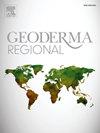俄罗斯北极地区受城市和工业污染土壤中的微生物群落
IF 3.1
2区 农林科学
Q2 SOIL SCIENCE
引用次数: 0
摘要
俄罗斯北极地区为研究恶劣气候条件下人为压力对土壤微生物群落的影响提供了独特的环境。这项研究通过比较摩尔曼斯克地区受城市和工业污染的土壤与天然 Podzols,研究了化学污染对土壤微生物特性的影响。与自然土壤相比,城市土壤发生了重大变化,包括 pH 值的变化以及碳和养分含量的增加。铜镍冶炼厂附近受工业污染的土壤重金属浓度较高,而铝冶炼厂附近的土壤氟和铝含量较高。在这两种情况下,碳含量和 pH 值都与天然土壤相似。工业排放物极大地改变了土壤微生物群,其影响因污染源和排放物的化学成分而异。铜镍冶炼厂附近的土壤显示细菌基因拷贝数和放线菌菌丝长度下降,主要是绿藻和子囊菌。相反,铝冶炼厂附近的土壤变化则不太明显,主要是变形菌和担子菌。尽管存在这些差异,但无论排放物的成分如何,这两个受工业影响的地点的微生物多样性都有所降低。相比之下,城市土壤中的微生物多样性有所增加,这可能是由于出现了新的、有利的生态位。两个城市的微生物群落相似,都以变形菌和子囊菌为主,与自然土壤相比,细菌基因拷贝数有所增加。这些发现凸显了城市和工业发展对土壤微生物群落的不同影响。工业活动抑制了微生物的生存,而城市化则促进了新壁龛的形成,提高了微生物的多样性。这凸显了城市土壤支持多样化微生物群落的潜力,这对北极城市的可持续发展和生态战略至关重要。本文章由计算机程序翻译,如有差异,请以英文原文为准。
Microbial communities of urban and industrial polluted soils in the Russian Arctic
The Russian Arctic presents a unique environment for studying the effects of anthropogenic pressure on soil microbial communities under severe climatic conditions. This study investigated the impact of chemical pollution on soil microbial properties by comparing urban and industrially polluted soils in Murmansk region with natural Podzols. Urban soils exhibited significant alterations, including shifts in pH and increased carbon and nutrient contents compared to natural soils. Industrially polluted soils near the copper‑nickel smelter were characterized by elevated heavy metal concentration, while those near the aluminum smelter showed high fluorine and aluminum content. In both cases, carbon content and pH remained similar to natural soils. Industrial emissions significantly changed the soil microbiome, with effects varying depending on the pollution source and chemical composition of the emissions. Soils near the copper‑nickel smelter showed a decline in bacterial gene copies and actinomycete mycelium length, with a predominance of Chloroflexii and Ascomycota. Conversely, soils near the aluminum smelter exhibited less pronounced changes, with Proteobacteria and Basidiomycota being prevalent. Despite these differences, both industrially impacted sites displayed reduced microbial diversity, regardless of the composition of the emissions. In contrast, urban soils demonstrated increased microbial diversity, likely attributed to the emergence of new, favorable ecological niches. Microbial communities in both cities were similar, dominated by Proteobacteria and Ascomycota, and displayed an increase in bacterial gene copies compared to natural soils. These findings highlight the contrasting influences of urban and industrial development on soil microbial communities. While industrial activities suppress microbial life, urbanization fosters the creation of new niches, promoting microbial diversity. This underscores the potential of urban soils to support diverse microbial communities, which is crucial for sustainable development and ecological strategies in Arctic cities.
求助全文
通过发布文献求助,成功后即可免费获取论文全文。
去求助
来源期刊

Geoderma Regional
Agricultural and Biological Sciences-Soil Science
CiteScore
6.10
自引率
7.30%
发文量
122
审稿时长
76 days
期刊介绍:
Global issues require studies and solutions on national and regional levels. Geoderma Regional focuses on studies that increase understanding and advance our scientific knowledge of soils in all regions of the world. The journal embraces every aspect of soil science and welcomes reviews of regional progress.
 求助内容:
求助内容: 应助结果提醒方式:
应助结果提醒方式:


